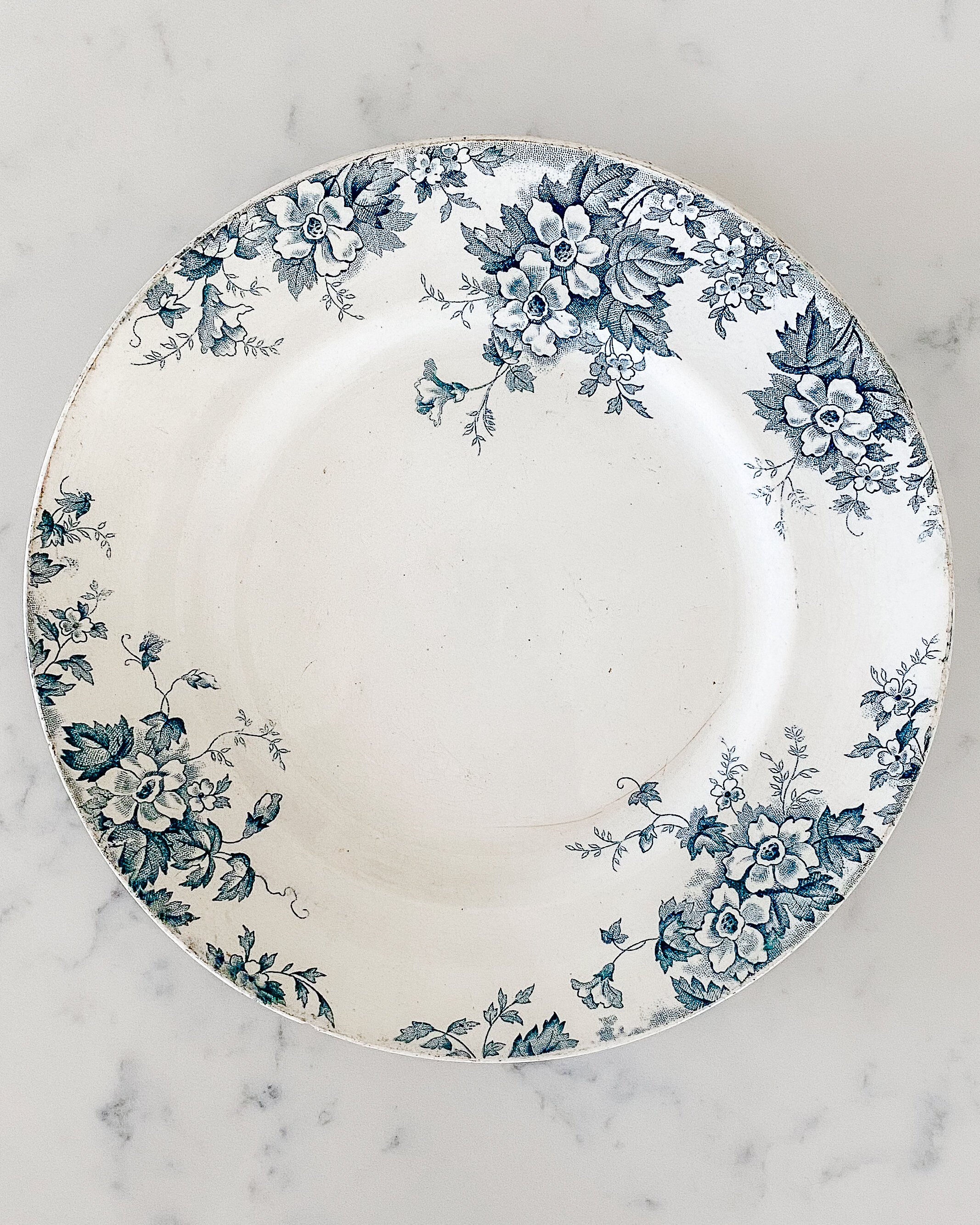Saint-Amand et Hamage Nord Marie-Louise Transferware Plates (Set of 8)
A set of 8 beautiful blue and white vintage French dinner plates by faience company St. Amand & Hamage Nord. The plates feature a lovely blue anemone floral design around the rim against a white background. The design is called "Marie Louise", and the maker’s mark on the underside indicates the plates were made between 1896 - 1952.
Transferware, which got its start in Italy in the late 17th century, is glazed ceramic ware decorated using an engraved copper or steel plate, which is printed onto paper and then transferred onto a ceramic piece. French faience came into being in 1689 when King Louis XIV needed money and taxed tableware made of gold and silver.
History of Saint-Amand et Hamage Nord Pottery: Saint-Amand-les-Eaux is located in the North of France and was first established in 1705 by Nicolas Desmoutiers, producing pottery painted with tin glaze. His products are characterized by multicolored decorations as well as blue camaïeu decors and grand feu (decoration with flowers or animals). In 1896 a second factory is opened in Wandignies-Hamage and the brand "Saint Amand and Hamage Nord" is registered. In 1952, the factory of Wandignies-Hamage ("Saint Amand et Hamage Nord") closes its doors, and by 1954 only a small company remains under the name "Les Grands Etablissements Céramique", which eventually closes in 1962.
Found in France
Small chip on the front edge of one plate
A couple plates have a small chip on the underside
Plates contain some minor crazing and staining
Overall condition consistent with age and use
Each plate measures approximately 9” W x .75” H
Available for pick up, local delivery, and nationwide shipping.
Need help with an item? Email Us
Request a trade discount here.
A set of 8 beautiful blue and white vintage French dinner plates by faience company St. Amand & Hamage Nord. The plates feature a lovely blue anemone floral design around the rim against a white background. The design is called "Marie Louise", and the maker’s mark on the underside indicates the plates were made between 1896 - 1952.
Transferware, which got its start in Italy in the late 17th century, is glazed ceramic ware decorated using an engraved copper or steel plate, which is printed onto paper and then transferred onto a ceramic piece. French faience came into being in 1689 when King Louis XIV needed money and taxed tableware made of gold and silver.
History of Saint-Amand et Hamage Nord Pottery: Saint-Amand-les-Eaux is located in the North of France and was first established in 1705 by Nicolas Desmoutiers, producing pottery painted with tin glaze. His products are characterized by multicolored decorations as well as blue camaïeu decors and grand feu (decoration with flowers or animals). In 1896 a second factory is opened in Wandignies-Hamage and the brand "Saint Amand and Hamage Nord" is registered. In 1952, the factory of Wandignies-Hamage ("Saint Amand et Hamage Nord") closes its doors, and by 1954 only a small company remains under the name "Les Grands Etablissements Céramique", which eventually closes in 1962.
Found in France
Small chip on the front edge of one plate
A couple plates have a small chip on the underside
Plates contain some minor crazing and staining
Overall condition consistent with age and use
Each plate measures approximately 9” W x .75” H
Available for pick up, local delivery, and nationwide shipping.
Need help with an item? Email Us
Request a trade discount here.
A set of 8 beautiful blue and white vintage French dinner plates by faience company St. Amand & Hamage Nord. The plates feature a lovely blue anemone floral design around the rim against a white background. The design is called "Marie Louise", and the maker’s mark on the underside indicates the plates were made between 1896 - 1952.
Transferware, which got its start in Italy in the late 17th century, is glazed ceramic ware decorated using an engraved copper or steel plate, which is printed onto paper and then transferred onto a ceramic piece. French faience came into being in 1689 when King Louis XIV needed money and taxed tableware made of gold and silver.
History of Saint-Amand et Hamage Nord Pottery: Saint-Amand-les-Eaux is located in the North of France and was first established in 1705 by Nicolas Desmoutiers, producing pottery painted with tin glaze. His products are characterized by multicolored decorations as well as blue camaïeu decors and grand feu (decoration with flowers or animals). In 1896 a second factory is opened in Wandignies-Hamage and the brand "Saint Amand and Hamage Nord" is registered. In 1952, the factory of Wandignies-Hamage ("Saint Amand et Hamage Nord") closes its doors, and by 1954 only a small company remains under the name "Les Grands Etablissements Céramique", which eventually closes in 1962.
Found in France
Small chip on the front edge of one plate
A couple plates have a small chip on the underside
Plates contain some minor crazing and staining
Overall condition consistent with age and use
Each plate measures approximately 9” W x .75” H
Available for pick up, local delivery, and nationwide shipping.
Need help with an item? Email Us
Request a trade discount here.
















